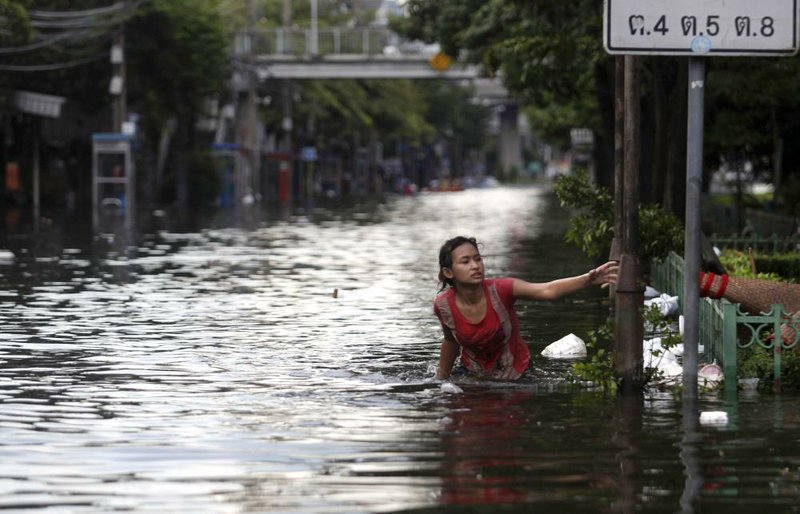BANGKOK, Thailand — Amid heightened fears that floodwaters could swamp Bangkok, saffron-robed monks and soldiers piled sandbags outside the city’s most-treasured temples and palaces Friday as the Thai capital’s main river swelled precariously beyond its banks, spilling ankle-high water briefly into some of the main tourist districts.
High tides expected to peak today are pushing the Chao Phraya River to its brink, and the rising water is posing one of the biggest tests yet to the city’s anti-flood defenses. Overflows so far have lightly inundated riverside streets from Chinatown to the white-walled royal Grand Palace and the neighboring Temple of the Emerald Buddha.
Most of the water has receded at low tide. Still, some worried Bangkokians are buying up bright orange life jackets and inflatable boats, fearing the worst is yet to come.
“You have to prepare,” said Fon Kanokporn, a banker who bought a rubber boat from a store that had several hanging from trees out front as advertisements.
Employees at the shop said they had sold more than 3,000 boats in the past week. The brisk business is a measure of the fear gripping Bangkok and a reflection of the tragedy of neighboring provinces that have been submerged for weeks. Several buyers said they needed boats because their submerged homes outside the capital were no longer accessible by road.
Three months of relentless monsoon rains have caused the worst flooding in Thailand in nearly 60 years, triggering a national crisis that has overwhelmed Prime Minister Yingluck Shinawatra’s government.
The water has crept from the central plains south toward the Gulf of Thailand for weeks, engulfing a third of the country and killing nearly 400 people and displacing 110,000 more. Now, Bangkok is in the way, surrounded by behemoth pools of water flowing around and through the city via a complex network of canals and rivers.
The government is worried major barriers and dikes could break since they were never designed to hold back so much water for so long. This weekend, higher than normal tides are obstructing the critical flow of runoff from the north, fueling fears that parts of downtown could be swamped.
On Friday, army trucks dumped thousands of sandbags outside the riverside Siriraj Hospital, where Thailand’s ailing and revered King Bhumibol Adulyadej has stayed since 2009.
Elsewhere along the Chao Phraya, dozens of monks at the 200-year-old Temple of the Dawn stacked hundreds more along a secondary barrier to protect against river overflows.
“It’s likely going to get higher, but I don’t think its going to get high enough to cause chaos,” said Phramaha Abhin, a 42-year-old monk. Still, he said, “we cannot neglect the risk to this temple. It’s one of the country’s landmarks, one of the things Thailand is known for. We have to protect it.”
So far, most of the city has remained untouched, and tourists are still snapping pictures in riverside districts as always.
But little by little, the city is slowing down.
This week, floodwaters pushed into Don Muang airport, used mostly for domestic flights, shutting it down. On Friday, the State Railway of Thailand said all train services from Bangkok to southern Thailand were suspended after the tracks in Bangkok’s suburbs were submerged by floodwaters.
Thais and expatriates alike continued to leave Bangkok as foreign governments urged their citizens to avoid the threatened city, citing transportation difficulties and shortages of certain food items.
Seven of Bangkok’s 50 districts, all in the northern outskirts, are heavily flooded, and residents have fled aboard bamboo rafts and army trucks and by wading through waistdeep water. Eight other districts have seen less serious flooding.
New flooding was reported Friday in the city’s southeast when a canal overflowed in a neighborhood on the outer parts of Sukhumvit Road.
“It is clear that although the high tides haven’t reached 2.5 meters, it was high enough to prolong the suffering of those living outside of the flood walls and to threaten those living behind deteriorating walls,” Bangkok Gov. Sukhumbhand Paribatra said.
The flood walls protecting much of the inner city are 8.2 feet high, and today’s high tide is expected to reach 8.5 feet.
The international charity Save the Children said it was concerned that crocodiles and snakes were lurking in stagnant floodwaters it said are growing filthier by the day.
“Every day we see children playing in the water, bathing or wading through it trying to make their way to dry ground,” said Annie Bodmer-Roy, the group’s spokesman in Thailand.
The aid group said many families have been left without access to running water or clean toilets.
“There is a very real risk of waterborne or communicable diseases such as diarrhea and skin infections taking hold if families can’t maintain basic standards of hygiene,” Bodmer-Roy said.
Information for this article was contributed by Vee Intarakratug and Chris Blake of The Associated Press.
Front Section, Pages 8 on 10/29/2011
